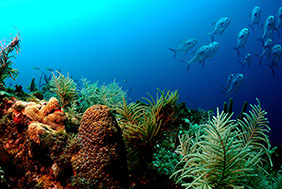-
Home
-
Data & Publications
-
Regional Portals
- About Regional Portals
- Florida
- Navassa Island
- Puerto Rico
- Flower Garden Banks
- U.S. Virgin Islands
- American Samoa
- Commonwealth of the Northern Mariana Islands
- Federated States of Micronesia
- Guam
- Main Hawaiian Islands
- Republic of the Marshall Islands
- Northwestern Hawaiian Islands
- Republic of Palau
- Pacific Remote Island Areas
-
CRCP Activities
- Glossary
US Coral Reef Monitoring Data Summary 2018

The National Coral Reef Monitoring Program (NCRMP) supports conservation of the nation's coral reef ecosystems through documenting and understanding the status and trends of climate, fish, benthic, and socioeconomic variables. Since its inception in 2001, NOAA's Coral Reef Conservation Program (CRCP) has supported monitoring in U.S. coral reef areas, and in 2013 these monitoring activities were consolidated within the framework of the NCRMP. The NCRMP is a cohesive NOAA-wide effort coordinating monitoring activities for biological, physical, and human dimensions of coral reefs. Through its implementation, NOAA can clearly and concisely communicate results of national-scale monitoring to national, state, and territorial policy makers, resource managers, and the public on a periodic basis. The NCRMP is limited to shallow water (0-30 m) coral reef ecosystems in the following ten CRCP priority geographic areas: U.S. Virgin Islands (USVI), Puerto Rico (PR), Florida (FL), Flower Garden Banks (FGB), American Samoa (AS), main Hawaiian Islands, northwest Hawaiian islands (main and northwest combined in this report as Hawai'i), Commonwealth of the Northern Mariana Islands (CNMI), Guam, and the Pacific Remote Island Areas (PRIA, including Wake, Johnston, Palmyra, and Kingman Atolls and Howland, Baker and Jarvis Islands).
Report Objectives and Audience
The NCRMP is committed to making data and data products publically available in a timely and user- friendly format to a wide variety of audiences. This data summary report presents quantitative data for human, biological and physical variables. Data are summarized at the island and within-island scale ('georegions') for the priority areas of the Pacific and at the habitat scale ('strata') for the priority areas of the Atlantic/Caribbean. Sector (Pacific) and habitat strata (Atlantic/Caribbean) represent the highest spatial resolution summary data (often averages) can be reported at, given the stratified-random sampling design.
This U.S.-wide data summary report is the first developed since the formal implementation of the NCRMP in 2013. The primary audience for this data summary report and the publically available summary data is the scientific and management community. Greater than 95% of the data presented in this report was collected between 2015 and 2017. All summary-level data presented within the report are available via the NOAA Coral Reef Information System (CoRIS), and raw data are available through the National Centers for Environmental Information (NCEI). The methods used to collect the data presented within this report can be found within documents made available with this report on the NOAA CoRIS webpage.
This data summary report presents data in maps, graphs, charts, tables and other figures and clearly describes what the data are. The focus here is on compelling presentation of the data and making the data publically available in accompanying user-friendly data tables. The data are presented and described rather than interpreted. Ongoing and future research by the scientific and management community - the target audience - can help explain the data presented, and the drivers of data patterns. This and other NCRMP reporting products will evolve in future years to address feedback and meet needs. As examples, future reporting products will examine trends in the status of coral reef and reef fish communities, and integrate social, ecological, chemical and physical data.
Report structure
The data summary report consists of a report for each of the priority geographic areas. The reports for each area have three sections: Human Connections, Coral Reefs and Reef Fish, and Ocean Chemistry and Temperature.
Human Connections: This section presents data from social surveys and secondary information sources on demographics, values, resource use, information sources; perceptions of resource condition, threats and severity; and, perceptions of reef management policies.
Coral Reefs and Reef Fish: This section presents data on benthic cover, adult and juvenile coral density, coral disease and coral mortality, the biomass and size-class distribution of reef fish, and the presence or absence of ESA-listed corals.
Ocean Chemistry and Temperature: This section presents data on aragonite saturation state, calcification accretion, pH, sub-surface temperature, and remotely sensed observations of temperature anomalies and thermal stress from NOAA Coral Reef Watch.
The area reports can be seen as modules within the larger data summary report. Readers can navigate to each part of the report using the hyperlinks in the Table of Contents and can navigate from the area reports back to the Table of Contents.
Citation: NOAA (2018) US Coral Reef Monitoring Data Summary 2018. NOAA Coral Reef Conservation Program. NOAA Technical Memorandum CRCP 31, 224 pp.
US Coral Reef Monitoring Data Summary 2018: (full report, pdf 120 MB)
For more information, contact: NOAA's Coral Reef Conservation Program


